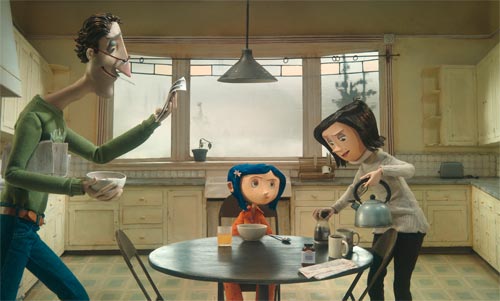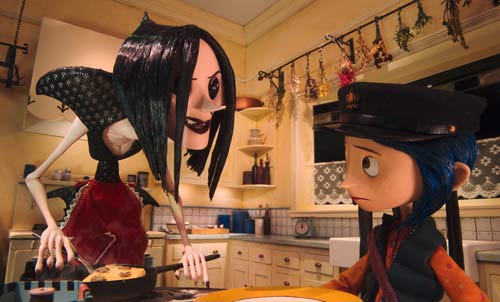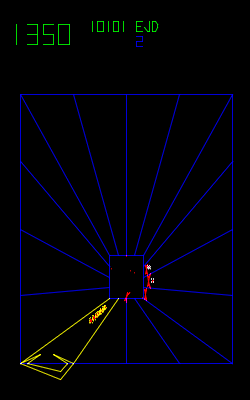
Laika / Focus Features
Henry Selick's Coraline
During the opening credits of Coraline, a thick sewing needle, manipulated by a vaguely sinister, vaguely mechanical praying mantis, pushed out of the screen at me as it zigged through the seams of stuffed dolls. Yes, I said, tapping the temple of my theater-issued, circularly polarized 3D glasses: these things are workin'.
But then a funny thing happened. Or didn't happen, actually. Once the mechanized seamstress passed the 3D test with flying colors, the movie rarely poked out at me again. Maybe the button-eyed character known as the Other Father reached his spring-loaded hands toward Coraline (and the camera, and me) a couple of times, but for the most part this is not the kind of 3D movie that tries to exceed the limits of the screen and get in your face. Instead, it does something I'd never seen before, something far more captivating: it maintains the consistent illusion that we're looking at a moving diorama just on the other side of the screen.
The in-your-face effects of many 3D films have a pretty narrow field of movement, approximately the size and shape of the old Tempest arcade game, a pyramid seen through the bottom whose edges will instantly jerk needles or fists or pistols back from your nose and flatten them into two dimensions whenever the hovering objects touch the illusion-destroying frame.

It's a Good Life, third segment of Twlight Zone: The Movie, by Joe Dante
Instead of working to break out of the rectangle, artificially, Coraline establishes the frame as a window that looks into a three dimensional world, which frees the viewers' eyeballs to roam that space looking for details in the corners. Sometimes the screen is a window pane with raindrops running down its surface — between the audience and the moving figures — and sometimes the pane is lifted to give an unobstructed view. I suppose the roving camera and the edits themselves remind us that we're watching a movie, but within each shot it's easy enough to imagine that you're sticking your head into the box and moving it around, with the camera as your surrogate.
That world, by the way, is a dark and scary one that borrows a few ideas from Alice in Wonderland and Through the Looking Glass (and, I'm told, from MirrorMask, which is based on a book by the same author as Coraline, Neil Gaiman), but it finds horror on the other side rather than absurdity. Coraline is closer in spirit to that wonderful/terrible world in the Twilight Zone movie where the family is forced to watch cartoons and eat marshmallows around the clock, or else face the wrath of sweet, adorable Anthony. Here, understimulated, imaginative Coraline, left by her busy parents to explore her new house, opens a small plastered-over door that leads to an alternate universe. Everything is the same over there, but much better. Her parents are attentive, the food is delicious, the colors are warm and vibrant, and the neighbors are fabulous, bawdy entertainers. But the Other World has a dark side, too. For instance, you really shouldn't leave. And the Other Mother wants to eat the souls of children.
Continue Reading







